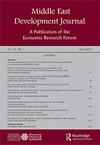Microeconomic analysis of private returns to education in Egypt: an instrumental variable quantile regression approach
IF 0.8
Q4 DEVELOPMENT STUDIES
引用次数: 1
Abstract
ABSTRACT This study provides updated estimates for the rate of return to an additional year of schooling in Egypt. Additionally, it addresses the major issues of heterogeneous returns and endogeneity of educational attainment. Instrumental variable quantile regression along with other models is employed for that objective. The paper uses the most recent issues of the Harmonized Labor Force Survey and Egypt Labor Market Panel Survey from 2008 to 2018. The findings can be summarized as follows: the returns increase over time up to 2015 then decreases to reach 5.67% in 2018, a number that falls below the global average. Moreover, females’ returns to education are higher than males; the returns are also higher in urban areas compared to rural ones providing an evidence that there exists developmental bias towards urban regions in Egypt. In line with preceding studies, the instrumental variable two-stage least squares estimates are higher than the ordinary least squares’ estimates. Additionally, a confirmation of heterogeneous returns across the wage distribution is presented. The instrumental variable quantile regression estimates exhibit an increasing pattern across the levels of wages. Thus, the less able individuals gain lower marginal profits of education than do the more gifted employees. Indicating complementarity between education and unobservable characteristics and that education may aggravate wage inequality in Egypt. Furthermore, it confirms the presence of the over-education crisis. Moreover, the region-based results in terms of the ability explanation provide that education complements low ability in rural areas while it compensates it in urban ones.埃及私人教育回报的微观经济分析:工具变量分位数回归方法
本研究提供了埃及每增加一年学校教育回报率的最新估计。此外,它解决了异质性回报和教育成就内生性的主要问题。工具变量分位数回归以及其他模型被用于这一目标。本文使用了2008年至2018年协调劳动力调查和埃及劳动力市场小组调查的最新版本。研究结果可以总结如下:到2015年,回报率随着时间的推移而增加,然后在2018年下降到5.67%,低于全球平均水平。此外,女性的教育回报高于男性;与农村地区相比,城市地区的回报也更高,这证明埃及存在着对城市地区的发展偏见。与之前的研究一致,工具变量两阶段最小二乘估计高于普通最小二乘估计。此外,还证实了工资分布中的异质性回报。工具变量分位数回归估计在工资水平上呈现出增加的模式。因此,能力较差的人获得的教育边际利润低于较有天赋的员工。表明教育与不可观察特征之间的互补性,以及教育可能加剧埃及的工资不平等。此外,它证实了过度教育危机的存在。此外,在能力解释方面,基于区域的结果表明,教育对农村地区的低能力有补充作用,而对城市地区的低能力有补偿作用。
本文章由计算机程序翻译,如有差异,请以英文原文为准。
求助全文
约1分钟内获得全文
求助全文

 求助内容:
求助内容: 应助结果提醒方式:
应助结果提醒方式:


